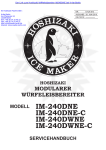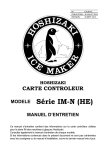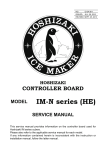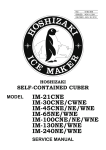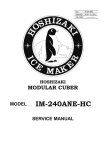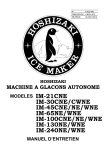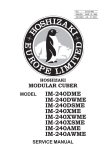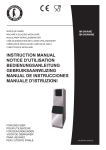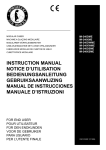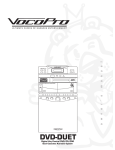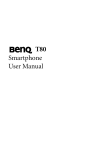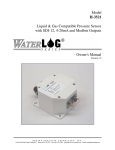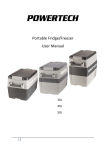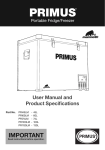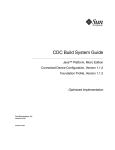Download Manual - Hoshizaki Lancer
Transcript
NO. E1CK-810 ISSUED: JUN. 28, 2010 REVISED: AUG. 18, 2012 HOSHIZAKI MODULAR CUBER MODEL IM-240DNE(-C) IM-240DWNE(-C) IM-240XNE(-C) IM-240XWNE(-C) IM-240ANE IM-240AWNE SERVICE MANUAL CONTENTS PAGE I. SPECIFICATIONS--------------------------------------------------------------------------------------1 1. DIMENSIONS/SPECIFICATIONS---------------------------------------------------------------1 [a] IM-240DNE [Copeland compressor: auxiliary code B0 and earlier]----------------1 [b] IM-240DNE [Danfoss compressor: auxiliary code B1 and later]--------------------2 [c] IM-240DNE-C------------------------------------------------------------------------------------3 [d] IM-240DWNE [Copeland compressor: auxiliary code B0 and earlier]-------------4 [e] IM-240DWNE [Danfoss compressor: auxiliary code B1 and later]-----------------5 [f] IM-240DWNE-C----------------------------------------------------------------------------------6 [g] IM-240ANE [Copeland compressor: auxiliary code B0 and earlier]----------------7 [h] IM-240ANE [Danfoss compressor: auxiliary code B1 and later]--------------------8 [i] IM-240AWNE [Copeland compressor: auxiliary code B0 and earlier]--------------9 [i] IM-240AWNE [Danfoss compressor: auxiliary code B1 and later]----------------- 10 II. GENERAL INFORMATION------------------------------------------------------------------------ 11 1. CONSTRUCTION--------------------------------------------------------------------------------- 11 [a] IM-240DNE/XNE, IM-240DNE-C/XNE-C------------------------------------------------ 11 [b] IM-240DWNE/XWNE, IM-240DWNE-C/XWNE-C------------------------------------ 12 [c] IM-240ANE-------------------------------------------------------------------------------------- 13 [d] IM-240AWNE----------------------------------------------------------------------------------- 14 2. CONTROLLER BOARD------------------------------------------------------------------------- 15 [a] CONTROLLER BOARD LAYOUT-------------------------------------------------------- 16 [b] INPUT/OUTPUT LAYOUT------------------------------------------------------------------ 17 [c] BEFORE CHECKING CONTROLLER BOARD--------------------------------------- 18 III. OPERATING INSTRUCTIONS------------------------------------------------------------------- 19 1. START UP------------------------------------------------------------------------------------------- 19 2. PREPARING THE ICEMAKER FOR LONG STORAGE--------------------------------- 20 3. BIN CONTROL------------------------------------------------------------------------------------- 21 [a] BIN CONTROL SWITCH ASSEMBLY--------------------------------------------------- 21 [b] REMOVAL--------------------------------------------------------------------------------------- 22 IV. MAINTENANCE INSTRUCTIONS-------------------------------------------------------------- 23 1. PERIODICAL CLEANING----------------------------------------------------------------------- 23 2. WATER VALVE------------------------------------------------------------------------------------- 25 3. WATER-COOLED CONDENSER------------------------------------------------------------- 26 4. ICEMAKING WATER SYSTEM---------------------------------------------------------------- 27 V. TECHNICAL INFORMATION---------------------------------------------------------------------- 30 1. WATER CIRCUIT AND REFRIGERANT CIRCUIT---------------------------------------- 30 [a] IM-240DNE/XNE, IM-240DNE-C/XNE-C, IM-240ANE------------------------------ 30 [b] IM-240DWNE/XWNE, IM-240DWNE-C/XWNE-C, IM-240AWNE---------------- 31 2. WIRING DIAGRAM------------------------------------------------------------------------------- 32 3. PERFORMANCE DATA-------------------------------------------------------------------------- 33 [a] COPELAND COMPRESSOR-------------------------------------------------------------- 33 [b] SECOP (DANFOSS) COMPRESSOR--------------------------------------------------- 36 i VI. SERVICE DIAGNOSIS---------------------------------------------------------------------------- 39 1. ERROR CODE INDICATION------------------------------------------------------------------- 39 2. NO ERROR CODE INDICATION-------------------------------------------------------------- 40 VII. ADJUSTMENT-------------------------------------------------------------------------------------- 42 1. EXPANSION VALVE------------------------------------------------------------------------------ 42 2. WATER REGULATING VALVE - WATER-COOLED MODEL ONLY------------------ 43 VIII. REMOVAL AND REPLACEMENT------------------------------------------------------------- 44 1. SERVICE FOR REFRIGERANT LINES----------------------------------------------------- 44 [a] SERVICE INFORMATION------------------------------------------------------------------ 44 [b] REFRIGERANT RECOVERY-------------------------------------------------------------- 45 [c] EVACUATION AND RECHARGE--------------------------------------------------------- 45 2. COMPRESSOR------------------------------------------------------------------------------------ 46 3. DRIER------------------------------------------------------------------------------------------------ 47 4. EXPANSION VALVE------------------------------------------------------------------------------ 48 5. EVAPORATOR------------------------------------------------------------------------------------- 49 6. HOT GAS VALVE---------------------------------------------------------------------------------- 50 7. WATER REGULATING VALVE - WATER-COOLED MODEL ONLY------------------ 51 [a] VALVE BODY---------------------------------------------------------------------------------- 51 [b] WHOLE VALVE-------------------------------------------------------------------------------- 51 8. WATER PAN ASSEMBLY----------------------------------------------------------------------- 53 9. PUMP MOTOR------------------------------------------------------------------------------------- 55 10. WATER VALVE------------------------------------------------------------------------------------ 55 11. ACTUATOR MOTOR----------------------------------------------------------------------------- 56 12. CAM ARM------------------------------------------------------------------------------------------- 56 [a] CAM ARM (A) - ACTUATOR MOTOR SIDE-------------------------------------------- 56 [b] CAM ARM (B) - REAR SIDE--------------------------------------------------------------- 56 13. CONTROLLER BOARD------------------------------------------------------------------------- 59 14. THERMISTOR FOR CUBE CONTROL------------------------------------------------------ 61 15. FAN MOTOR - AIR-COOLED MODEL ONLY---------------------------------------------- 62 IX. MULTI-STACK APPLICATIONS----------------------------------------------------------------- 63 ii I. SPECIFICATIONS 1. DIMENSIONS/SPECIFICATIONS [a] IM-240DNE (Air-cooled) [Copeland compressor: auxiliary code B0 and earlier] 1 [b] IM-240DNE (Air-cooled) [Danfoss compressor: auxiliary code B1 and later] 2 [c] IM-240DNE-C (Air-cooled) 3 [d] IM-240DWNE (Water-cooled) [Copeland compressor: auxiliary code B0 and earlier] 4 [e] IM-240DWNE (Water-cooled) [Danfoss compressor: auxiliary code B1 and later] 5 [f] IM-240DWNE-C (Water-cooled) 6 [g] IM-240ANE (Air-cooled) [Copeland compressor: auxiliary code B0 and earlier] 7 [h] IM-240ANE (Air-cooled) [Danfoss compressor: auxiliary code B1 and later] 8 [i] IM-240AWNE (Water-cooled) [Copeland compressor: auxiliary code B0 and earlier] 9 [j] IM-240AWNE (Water-cooled) [Danfoss compressor: auxiliary code B1 and later] 10 II. GENERAL INFORMATION 1. CONSTRUCTION [a] IM-240DNE/XNE, IM-240DNE-C/XNE-C (Air-cooled) Top Panel Louver, Air Filter Front Panel Bin Door Handle Bin Evaporator Water Plate Water Valve Bin Control Switch Hot Gas Valve Water Tank Power Cord Pump Motor Control Box (B) Compressor Drain Pan Fan Motor Actuator Motor Control Box (A) Air-Cooled Condenser 11 [b] IM-240DWNE/XWNE, IM-240DWNE-C/XWNE-C (Water-cooled) Top Panel Front Panel Bin Door Handle Bin Evaporator Water Valve Water Plate Bin Control Switch Hot Gas Valve Water Tank Power Cord Pump Motor Water Regulator Compressor Drain Pan Actuator Motor Control Box (A) Water-Cooled Condensor Control Box (B) 12 [c] IM-240ANE (Air-cooled) Top Panel Power Cord Nameplate Louver, Air Filter Front Panel Bin Door Handle Water Valve Bin Drain Pipe Rear Front Compressor Hot Gas Valve Fan Motor Control Box Air-Cooled Condenser Evaporator Water Plate Water Tank Actuator Motor Pump Motor Bin Control Switch Drain Pan Front 13 [d] IM-240AWNE (Water-cooled) Top Panel Power Cord Nameplate Front Panel Cooling Water Inlet Bin Door Handle Bin Cooling Water Outlet Water Valve Drain Pipe Rear Front Water-Cooled Condenser Hot Gas Valve Water Regulator Control Box Compressor Evaporator Water Plate Water Tank Actuator Motor Pump Motor Bin Control Switch Drain Pan Front 14 2. CONTROLLER BOARD Note: Refer to the controller board service manual. IMPORTANT If receiving a service call, ask the user to turn off the power to the icemaker and turn it on again, while watching the icemaker. This will reset the controller, and in some cases normal operation will resume. CAUTION 1. Check that the icemaker has been earthed properly. If not, the controller board will not work properly. 2. Do not change wiring and connections, or the controller board will not work properly. 3. Do not touch the reverse side of the controller board and tiny electronic devices on it. 4. Do not repair the electronic devices and parts on the controller board in the field (except for fuse replacement). Replace the whole board assembly when it fails. 5. To get static free, always touch the metal part of the icemaker before servicing. Electrostatic discharge will cause severe damage to the controller board. 6. The signal ground wire must be connected to the control box when replacing the controller board after service. 7. The controller board is fragile. Handle with care. * Do not drop the board on the floor. * Make sure that the board is placed correctly into the guides in the control box. Mis-alignment could cause breakage when replacing the control box cover. * Handle the board by the edges only. Do not touch the electric parts and devices. 15 [a] CONTROLLER BOARD LAYOUT Main Board Sub Board Combination 16 [b] INPUT/OUTPUT LAYOUT Hall IC Input XA Connector (4P) Bin Control Switch / Pressure Switch / Condenser Thermistor Input XA Connector (6P) Cube Control Thermistor Input XA Connector (2P) 7-Segment DoubleDigit Display Data Input/Output PA Connector (8P) Reset Button 10.5V AC Input VH Connector (2P) Close Button Open Button AC Low Voltage, DC Circuit AC High Voltage Circuit Actuator Drive Output VH Connector (3P) Pump Motor / Hot Gas Valve / Fan Motor / Water Valve / Compressor AC Relay Drive Output VH Connector (9P) 220-240V AC Input VYH Connector (3P) Fuse P01992-01 6.3A 17 [c] BEFORE CHECKING CONTROLLER BOARD Check the power source voltage and the components as shown in the table below. Component 1. Thermistor (on evaporator) Holder Screw Evaporator Thermistor 2. Bin Control Switch Procedure Normal CAUTION Thermistor sensor part is fragile, glass sealed. Handle with care. 5 -7 kilohms *Disconnect the connector CN13 on the board. *R e m o v e t h e s c r e w a n d t h e thermistor holder on the evaporator. *Immerse the sensor part in a glass containing ice and water for 5 minutes. *Check the resistance between CN13 connector pins. *Replace the thermistor in its correct position. *Connect CN13. Manually set the micro switch in the TRIP and RESET positions, and check the period. 18 Approx. TRIP(Closed) 10 sec. RESET(Open) 80 sec. III. OPERATING INSTRUCTIONS WARNING 1.This icemaker is designed to produce and store edible ice. To keep the icemaker hygienic: *Wash your hands before removing ice. Use the plastic scoop provided (accessory). *The storage bin is for ice use only. Do not store anything else in the bin. *C l e a n th e s to r a g e b i n b e fo r e u s e ( s e e “ IV. 1 . PE R IOD IC A L CLEANING”). *Keep the scoop clean. Clean it by using a neutral cleaner and rinse thoroughly. *Close the door after removing ice to prevent entrance of dirt, dust or insects into the storage bin. 2.The use of any electrical equipment involves the observance of some fundamental rules. In particular: *Instances of high humidity and moisture increase the risk of electrical short circuits and potential electrical shocks. If in doubt, disconnect the icemaker. *Do not pull the power cord in order to disconnect the icemaker from the feed network. *This appliance is not suitable for unsupervised use by young children or aged or infirm persons. 3.All parts are factory-adjusted. Improper adjustments may result in failure. 4.If the unit is turned off, wait for at least 3 minutes before restarting the icemaker to prevent damage to the compressor. 5.Do not put your hands into the back of the storage bin or the ice chute on top of the storage bin. Ice may drop off the icemaker, a hard block of ice may suddenly break down, or the icemaking mechanism may suddenly move, resulting in injury. 1. START UP 1) Disconnect the power supply. 2) Open the water tap. 3) Connect the power supply and energise. 19 4) The following should occur in sequence: a) Hot gas valve will open. b) Compressor will start. c) Water pan will fully open. d) Water valve will open. e) Water pan will start to close (hot gas valve closed). f) Water pan fully closed - pump motor will start. g) Water valve will close. 2. PREPARING THE ICEMAKER FOR LONG STORAGE WARNING Drain the icemaker to prevent damage to the water supply line at subfreezing temperatures, using air or carbon dioxide. Shut off the icemaker until proper air temperature is resumed. 1)Close the water supply tap, and remove the inlet hose. [Normal Position] 2)Remove the front panel. 3)Remove the screw located on the front of the water tank. 4)Move the tank drain pipe to the drain position. See Fig. 1. 5)Push the reset switch. The water pan will start to open. Screw Tank Drain Pipe [Drain Position] 6)Blow out the water supply line immediately after the water pan has opened. Note: This procedure is necessary to protect the icemaker from freezing up at subfreezing temperature. 7) Unplug the icemaker or disconnect the power source when the water pan has fully opened. Fig. 1 8) Move the tank drain pipe to the normal position, and secure it with the screw. 9) Remove all ice from the storage bin, and clean the bin. 20 10) Replace the panels in their correct positions. 11) Replace the inlet hose in its correct position. 3. BIN CONTROL Bin control switch is mounted on the upper side of the storage bin. This switch will turn off the unit automatically when the storage bin is full of ice. Handle the bin control switch carefully, because the switch assembly is fragile. Running Bin full Especially on removing ice, do not touch (Tripped) or poke with a scoop. Keep away from the water plate or drain Fig. 2 pan to prevent jamming. [a] BIN CONTROL SWITCH ASSEMBLY Bracket Microswitch Switch Actuator Bracket Cover Detector Fig. 3 21 Fragile Keep away from water plate or drain pan. [b] REMOVAL BRACKET COVER Push the two pawls and remove the bracket cover. SWITCH Pull out the switch, holding the rubber leads cap. Handle with care. SWITCH ACTUATOR Insert a flat blade screwdriver and wrench it slightly to pull out the switch actuator. Handle with care to prevent damage to the cam surface of the actuator. DETECTOR Push out the detector, holding the switch actuator. [c] REASSEMBLING SWITCH ACTUATOR Insert the lower shaft and push it along the U notch. Check that the switch actuator moves free. SWITCH & BRACKET COVER Place the switch lever first, and then attach the switch in position. Insert the guide and push the bracket cover to lock. Fig. 4 22 IV. MAINTENANCE INSTRUCTIONS WARNING 1. Before carrying out any cleaning or maintenance operations, unplug the icemaker from the electrical supply network. 2. Before handling or using cleaning solutions, check the guidelines on the product for advice on suitable personal protective clothing, gloves, goggles, etc. 3. Clean and sanitize the icemaker water system at least twice a year, and check and clean the condenser at least once a year. 4. This appliance must not be cleaned by use of a water jet. 1. PERIODICAL CLEANING [1] Machine and Bin Exterior Wipe the exterior at least once per week with a clean, soft cloth. Use a damp cloth containing a neutral cleaner to wipe off grease or dirt. [2] Scoop and Storage Bin Handle Cleaning/Sanitisation (Daily) 1) Either mix 3 litres of water with 11 ml of 5.25% sodium hypochlorite solution in a suitable container, or the recommended Hoshizaki sanitiser as directed. 2) Soak the scoop in the solution for more than 3 minutes. Rinse thoroughly, and shake to remove surplus liquid. Note: Using a cloth to dry may re-contaminate. 3) Use a neutral cleaner to wash the storage bin handle. Rinse thoroughly. 4) Soak a clean cloth with the sanitising solution, and wipe the handle. Use fresh water and a clean cloth to rinse/dry. [3] Storage Bin Interior Cleaning/Sanitisation (Weekly) 1) Open the storage bin door, and remove all ice. Note:Hoshizaki recommends various types of storage bin for the icemaker which vary in size and design. The following instructions are therefore for general guidance only. 23 2) Wash the bin liner, ice deflector and door inner surface with a neutral non-abrasive cleaner. Rinse thoroughly with a clean cloth and fresh water. 3) Either mix 5 litres of water with 18 ml of 5.25% sodium hypochlorite solution in a suitable container, or the recommended Hoshizaki sanitiser as directed. 4) Soak a clean sponge or cloth with the solution, and wipe the bin liner, ice deflector and door inner surface. 5) Rinse thoroughly with fresh water and a clean cloth to wipe off the solution. Close the bin door. Note: Some solutions may cause damage to the bin liner surfaces or corrosion on the metal parts. Always rinse the sanitiser unless directed otherwise by Hoshizaki guidelines. [4] Air Filter (Air-Cooled Model Only) Plastic mesh air filters remove dirt or dust from the air, and keep the condenser from getting clogged. If the filters get clogged, the icemaker’s performance will be reduced. Remove and clean the air filters at least twice per month: 1)Slide the air filter off the louver. 2)Clean the air filter by using a vacuum cleaner. When severely clogged, use warm water and a neutral cleaner to wash the air filter. 3)Rinse and dry the air filter thoroughly, and place it in position. Air Filter Louver Fig. 5 24 2. WATER VALVE 1) Unplug the icemaker or disconnect the power source. 2) Close the water supply tap. 3) Remove the top panel and front panel. 4) Disconnect the inlet hose from the water valve. 5) Remove the mesh filter from the water valve. 6) Clean the mesh using a brush. 7) Replace the mesh and inlet hose in their correct positions. 8) Open the shut-off valve. 9) Plug in the icemaker or connect the power source. 10) Check for leaks. 11) Replace the panels in their correct positions. Coil Do not remove Filter Packing Fig. 6 25 Inlet Hose 3. WATER-COOLED CONDENSER Deposits inside the water circuit of the water-cooled condenser decrease cooling performance. Clean inside of the condenser by circulating a cleaning solution. 1) Prepare the following: Cleaning solution [Read and follow any instructions on label or bottle.] Pump Container for solution Hose Hose bands Two fittings [R1/2 - 3/8”DIA] Two fittings [3/8” flare - 3/8”DIA] CAUTION Do not use a cleaning solution that will corrode the copper tubing. In case of contact with the solution, flush with water. 2) Remove the panels and check for leaks from the water line. 3) Unplug the icemaker or disconnect the power source, and close the water supply tap. 4) Disconnect the cooling water inlet and outlet pipings and attach fittings to connect hoses. 5) Disconnect the inlet and outlet tubings of the water regulator and replace the water regulator by fittings. 6) Connect hoses as shown in Fig. 7 and secure them by hose bands. Cleaner Hose Condenser Container Fig. 7 7) Fill the container with the cleaning solution. 8) Run the pump motor and circulate the solution for a period recommended in the instructions on label or bottle of the cleaner. 9) Rinse the water circuit. 26 10) Reverse the above procedure in steps 2) through 6). 11) Check the icemaking capacity referring to “V. 3. PERFORMANCE DATA”. 4. ICEMAKING WATER SYSTEM To keep the icemaker hygienic, clean and sanitize the icemaking water system at least once every six months. More frequent cleaning and sanitizing may be required depending on the water quality. CAUTION 1.Always wear rubber gloves, eye protectors, apron, etc. for safe handling of the cleaner and sanitizer. 2.Use the cleaners and sanitizers recommended by Hoshizaki. Contact your local Hoshizaki office for further details. (The instructions below give an example of those recommended cleaners and sanitizers.) 3.Never mix cleaning and sanitizing solutions in an attempt to shorten cleaning time. 4.Wipe off any splashed or spilt cleaner/sanitizer immediately. 5.Do not use any ammonia type cleaners on any part of the icemaker. 6.When the ambient and water temperatures are 10°C or below, the water pan may remain open. Warm the icemaking compartment up to 20°C around the thermistor. 7.Be sure to follow the cleaning and sanitizing instructions below. 1)Use a suitable container to dilute 236 ml of the cleaner (“Nickel-Safe Ice Machine Cleaner” by The Rectorseal Corporation) with 11.4 lit. of water. 2)Open the storage bin door, and remove all the ice to avoid contaminating by the cleaner. 3)Remove the front and top panels. 4)If the icemaker is in a defrost cycle, wait until a freeze cycle starts. 5)Close the water supply tap. 6)Remove the screw, and move the tank drain pipe to the drain position. See Fig. 1. 27 7)Push the reset switch to open the water pan. 8)Unplug the icemaker or disconnect the power source when the water pan has fully opened. 9)After the water has completely drained out, plug in the icemaker or connect the power source. When the 7-segment display on the controller board turns on, press SW1 on the controller board for 3 seconds to start the flush mode. (See the controller board service manual for further details.) 10)When the flush mode has started, pour the cleaning solution prepared in 1) carefully into the water tank within 60 seconds before the pump motor starts. Do not splash or spill the solution onto the other parts. 11)Circulate the cleaning solution for 30 minutes. Push the reset switch to open the water pan. Unplug the icemaker or disconnect the power source when the water pan has fully opened. Wait until the cleaning solution has completely drained out. 12)Open the water supply tap, and repeat the above step 9). Since the water supply tap is open this time, water is supplied as in the normal freeze cycle. 13)When the water pan closes again, pour clean water into the water pan until it floods from the overflow pipe, and circulate the water for 5 minutes. 14)Push the reset switch to open the water pan and drain the water. This time the water does not drain out completely. 15)Repeat the above steps 13) and 14) at least three times to rinse thoroughly. To drain the rinse water completely, unplug the icemaker or disconnect the power source when the water pan has fully opened. SANITIZING INSTRUCTIONS Note: Sanitizing should always be completed after cleaning or alternately as an individual procedure if conditions exist to make it necessary. 16)Use a suitable container to dilute 44 ml of 5.25% sodium hypochlorite solution with 11.4 lit. of water. * Alternatively use the Hoshizaki recommended sanitizer as directed by the relevant instructions. 17)Close the water supply tap. Plug in the icemaker or connect the power source. When the 7-segment display on the controller board turns on, press SW1 on the controller board for 3 seconds to start the flush mode. 28 18)When the flush mode has started, pour the cleaning solution prepared in 16) carefully into the water tank within 60 seconds before the pump motor starts. Do not splash or spill the solution onto the other parts. 19)Circulate the sanitizing solution for 15 minutes. Push the reset switch to open the water pan. Unplug the icemaker or disconnect the power source when the water pan has fully opened. Wait until the sanitizing solution has completely drained out. 20)Open the water supply tap, and repeat the above step 9). Since the water supply tap is open this time, water is supplied as in the normal freeze cycle. 21)When the water pan closes again, pour clean water into the water pan until it floods from the overflow pipe, and circulate the water for 5 minutes. 22)Push the reset switch to open the water pan and drain the water. This time the water does not drain out completely. 23)Repeat the above steps 21) and 22) at least three times to rinse thoroughly. To drain the rinse water completely, unplug the icemaker or disconnect the power source when the water pan has fully opened. 24) Move the tank drain pipe to the normal position, and secure it with the screw. See Fig. 1. 25)Plug in the icemaker or connect the power source. Check for proper icemaking operation. 26)Replace the front panel and top panel in their correct positions. 27)Complete storage bin cleaning as detailed in IV. 1. [3]. 29 V. TECHNICAL INFORMATION 1. WATER CIRCUIT AND REFRIGERANT CIRCUIT [a] IM-240DNE/XNE, IM-240DNE-C/XNE-C, IM-240ANE (Air-cooled) Water Valve Expansion Valve Evaporator Thermistor Controller Board Water Pan Expansion Valve Bulb Water Pump Condenser Thermistor Hot Gas Valve Strainer Fan Motor Compressor Drier Water Circuit Refrigerant Circuit 30 [b] IM-240DWNE/XWNE, IM-240DWNE-C/XWNE-C, IM-240AWNE (Water-cooled) Water Valve Expansion Valve Evaporator Thermistor Controller Board Water Pan Expansion Valve Bulb Water Pump Pressure Switch Water Regulating Valve Condenser Hot Gas Valve Drier Strainer Compressor Water Circuit Refrigerant Circuit 31 2. WIRING DIAGRAM 32 3. PERFORMANCE DATA [a] COPELAND COMPRESSOR (Ice Production = Capacity when shipped from factory) (*Values for icemaking water only. Use a cooling tower for cooling water.) Cube Hole Diameter: 5mm (15mm) for -28, -23, -32 3mm (7mm) for -21 Model IM-240DNE IM-240XNE IM-240DNE-23 IM-240XNE-23 IM-240DNE-21 IM-240XNE-21 IM-240DNE-32 IM-240XNE-32 IM-240DNE IM-240XNE (60Hz) IM-240DNE-23 IM-240XNE-23 (60Hz) IM-240DNE-21 IM-240XNE-21 (60Hz) IM-240DWNE IM-240XWNE Ambient Temp. (°C) Water Temp. (°C) Cube Hole Diameter Ice Production (kg/d) Freeze Cycle Time (min) Defrost Cycle Time (min) Water Consumption (lit/h) Electric Consumption (W) Head Pressure [peak] (bar) Ice Production (kg/d) Freeze Cycle Time (min) Defrost Cycle Time (min) Water Consumption (lit/h) Electric Consumption (W) Head Pressure [peak] (bar) Ice Production (kg/d) Freeze Cycle Time (min) Defrost Cycle Time (min) Water Consumption (lit/h) Electric Consumption (W) Head Pressure [peak] (bar) Ice Production (kg/d) Freeze Cycle Time (min) Defrost Cycle Time (min) Water Consumption (lit/h) Electric Consumption (W) Head Pressure [peak] (bar) Ice Production (kg/d) Freeze Cycle Time (min) Defrost Cycle Time (min) Water Consumption (lit/h) Electric Consumption (W) Head Pressure [peak] (bar) Ice Production (kg/d) Freeze Cycle Time (min) Defrost Cycle Time (min) Water Consumption (lit/h) Electric Consumption (W) Head Pressure [peak] (bar) Ice Production (kg/d) Freeze Cycle Time (min) Defrost Cycle Time (min) Water Consumption (lit/h) Electric Consumption (W) Head Pressure [peak] (bar) Ice Production (kg/d) Freeze Cycle Time (min) Defrost Cycle Time (min) Water Consumption (lit/h) Electric Consumption (W) Head Pressure [peak] (bar) 10 10 5mm(15mm) 230(240) 16.0(14.6) 4.0(3.4) 31.3(33.8) 1120 14.0 180(225) 15.0(11.0) 4.0(3.5) 33.0(41.8) 1120 14.0 190(217) 12.3(8.3) 3.6(3.6) 39.5(52.6) 1120 14.0 180(220) 21.9(16.5) 4.5(4.0) 23.8(29.7) 1120 14.0 235(245) 16.1(14.1) 3.5(3.5) 32.0(35.6) 1150 15.0 185(230) 14.8(10.5) 3.7(3.7) 31.7(41.4) 1150 15.0 200(220) 11.4(8.1) 3.7(3.7) 38.9(49.9) 1150 15.0 230(240) 17.8(16.2) 2.2(1.8) 31.3(34.1) 1250 19.5 33 21 15 5mm(15mm) 220(230) 18.2(16.8) 2.7(2.0) 15.7(16.8) 1200 17.0 175(215) 17.1(12.7) 2.5(2.5) 16.7(21.6) 1200 17.0 180(210) 14.5(10.2) 2.3(2.1) 19.5(26.2) 1200 17.0 175(200) 24.0(19.7) 3.2(3.0) 12.1(14.3) 1200 17.0 210(220) 19.4(17.1) 2.5(2.5) 14.9(16.7) 1200 18.0 180(215) 17.0(13.2) 2.0(2.0) 15.1(18.9) 1200 18.0 210(220) 12.4(9.8) 2.0(2.0) 20.0(24.4) 1200 18.0 215(225) 19.2(17.5) 2.2(1.7) 15.3(17.1) 1260 19.7 32 21 5mm(15mm) 200(210) 21.2(19.1) 1.8(1.5) 14.2(15.7) 1330 21.0 165(195) 19.1(15.1) 1.7(1.7) 15.8(19.6) 1330 21.0 165(190) 16.3(11.9) 2.0(1.7) 17.9(23.5) 1330 21.0 155(190) 28.7(21.9) 2.0(2.0) 10.7(13.7) 1330 21.0 200(210) 21.3(18.9) 1.7(1.7) 14.2(15.9) 1260 22.0 170(195) 18.5(15.1) 1.7(1.7) 14.3(17.2) 1260 22.0 180(190) 15.1(11.9) 1.7(1.7) 17.1(21.1) 1260 22.0 205(215) 20.7(18.5) 1.8(1.6) 14.6(16.2) 1300 19.8 38 32 5mm(15mm) 170(185) 25.4(21.9) 1.7(1.5) 12.1(13.9) 1450 25.0 145(160) 22.0(18.8) 1.6(1.6) 13.9(16.1) 1450 25.0 152(167) 18.1(13.8) 1.8(1.7) 16.5(21.0) 1450 25.0 130(140) 34.8(30.7) 1.8(1.7) 9.0(10.1) 1450 25.0 175(190) 24.6(21.0) 1.7(1.7) 12.5(14.4) 1300 26.0 150(165) 21.1(18.1) 1.7(1.7) 12.6(14.5) 1300 26.0 160(175) 17.2(13.1) 1.7(1.7) 15.2(19.4) 1300 26.0 185(200) 23.1(20.0) 1.8(1.6) 13.2(15.0) 1330 20.0 Model IM-240DWNE-23 IM-240XWNE-23 IM-240DWNE-21 IM-240XWNE-21 IM-240DWNE-32 IM-240DWNE-32 IM-240DWNE IM-240XWNE (60Hz) IM-240DWNE-21 IM-240XWNE-21 (60Hz) IM-240ANE IM-240ANE-23 IM-240AWNE Ambient Temp. (°C) Water Temp. (°C) Cube Hole Diameter Ice Production (kg/d) Freeze Cycle Time (min) Defrost Cycle Time (min) Water Consumption (lit/h) Electric Consumption (W) Head Pressure [peak] (bar) Ice Production (kg/d) Freeze Cycle Time (min) Defrost Cycle Time (min) Water Consumption (lit/h) Electric Consumption (W) Head Pressure [peak] (bar) Ice Production (kg/d) Freeze Cycle Time (min) Defrost Cycle Time (min) Water Consumption (lit/h) Electric Consumption (W) Head Pressure [peak] (bar) Ice Production (kg/d) Freeze Cycle Time (min) Defrost Cycle Time (min) Water Consumption (lit/h) Electric Consumption (W) Head Pressure [peak] (bar) Ice Production (kg/d) Freeze Cycle Time (min) Defrost Cycle Time (min) Water Consumption (lit/h) Electric Consumption (W) Head Pressure [peak] (bar) Ice Production (kg/d) Freeze Cycle Time (min) Defrost Cycle Time (min) Water Consumption (lit/h) Electric Consumption (W) Head Pressure [peak] (bar) Ice Production (kg/d) Freeze Cycle Time (min) Defrost Cycle Time (min) Water Consumption (lit/h) Electric Consumption (W) Head Pressure [peak] (bar) Ice Production (kg/d) Freeze Cycle Time (min) Defrost Cycle Time (min) Water Consumption (lit/h) Electric Consumption (W) Head Pressure [peak] (bar) 10 10 5mm(15mm) 185(210) 16.4(13.4) 2.1(2.1) 33.9(40.5) 1250 19.5 203(215) 12.9(10.1) 2.0(2.0) 42.2(52.1) 1250 19.5 180(215) 23.4(18.1) 3.0(3.0) 23.8(29.8) 1250 19.5 215(240) 19.0(16.4) 2.4(1.6) 29.3(33.4) 1085 20.0 205(215) 12.8(10.2) 2.0(1.9) 42.6(52.1) 1085 20.0 220(240) 15.9(14.0) 5.0(4.0) 30.0(33.1) 1145 14.0 185(225) 14.5(11.0) 4.0(3.5) 32.4(39.9) 1145 14.0 230(240) 17.8(16.2) 2.2(1.8) 31.3(34.1) 1250 19.5 34 21 15 5mm(15mm) 175(202) 17.5(14.0) 2.1(2.1) 16.7(20.4) 1260 19.7 193(207) 13.7(10.5) 2.0(2.0) 20..9(26.2) 1260 19.7 170(195) 25.5(20.8) 2.5(2.5) 11.7(14.1) 1260 19.7 205(220) 20.4(18.0) 2.1(1.6) 14.6(16.3) 1095 20.0 195(210) 13.7(10.5) 1.8(1.8) 21.2(26.6) 1095 20.0 205(230) 19.5(16.1) 3.0(2.7) 14.6(17.2) 1230 17.0 175(215) 17.1(12.7) 2.5(2.5) 13.9(17.9) 1230 17.0 215(225) 19.2(17.5) 2.2(1.7) 15.3(16.6) 1250 19.7 32 21 5mm(15mm) 168(185) 18.4(15.9) 2.0(1.7) 16.1(18.3) 1300 19.8 181(195) 14.7(11.5) 2.0(1.8) 19.6(24.3) 1300 19.8 160(180) 27..2(22.7) 2.5(2.5) 11.0(13.0) 1300 19.8 200(210) 21.1(19.0) 1.9(1.6) 14.2(15.7) 1130 20.5 190(200) 14.1(11.3) 1.8(1.7) 20.6(25.3) 1130 20.5 160(190) 26.8(21.0) 2.0(1.7) 11.4(14.2) 1320 21.0 165(195) 18.8(16.8) 2.0(1.8) 13.1(16.0) 1320 21.0 205(215) 20.7(18.5) 1.8(1.6) 14.6(16.2) 1300 19.8 38 32 5mm(15mm) 150(165) 20.8(18.0) 2.0(1.7) 14.4(16.6) 1330 20 170(185) 15.9(12.3) 1.9(1.7) 18.4(23.4) 1330 20 152(165) 28.8(25.0) 2.5(2.5) 10.5(11.9) 1330 20.0 180(195) 23.8(20.5) 1.8(1.7) 12.8(14.7) 1150 21.0 180(195) 15.0(11.6) 1.8(1.7) 19.5(24.7) 1150 21.0 150(165) 28.7(24.5) 2.0(1.7) 10.7(12.4) 1430 25.0 155(170) 20.2(17.4) 1.9(1.8) 12.3(14.1) 1430 25.0 185(200) 23.1(20.0) 1.8(1.6) 13.2(15.0) 1300 20.0 Model IM-240AWNE (60Hz) IM-240AWNE-23 (60Hz) IM-240AWNE-21 (60Hz) Model IM-240DNE-C IM-240XNE-C IM-240DWNE-C IM-240XWNE-C Ambient Temp. (°C) Water Temp. (°C) Head Pressure [peak] (bar) Cube Hole Diameter Ice Production (kg/d) Freeze Cycle Time (min) Defrost Cycle Time (min) Water Consumption (lit/h) Electric Consumption (W) Head Pressure [peak] (bar) Ice Production (kg/d) Freeze Cycle Time (min) Defrost Cycle Time (min) Water Consumption (lit/h) Electric Consumption (W) Head Pressure [peak] (bar) Ice Production (kg/d) Freeze Cycle Time (min) Defrost Cycle Time (min) Water Consumption (lit/h) Electric Consumption (W) Head Pressure [peak] (bar) Head Pressure [peak] (bar) 10 10 19.5 5mm(15mm) 215(240) 19.0(16.0) 2.4(2.0) 29.3(34.1) 1085 20.0 190(220) 15.6(12.9) 2.4(2.0) 34.8(42.3) 1085 20.0 205(215) 12.6(10.1) 2.2(2.0) 42.6(52.1) 1085 20.0 14.0 21 15 19.7 5mm(15mm) 205(220) 20.4(17.7) 2.1(1.9) 14.6(16.5) 1095 20.0 185(200) 16.3(14.5) 2.2(1.8) 17.7(20.1) 1095 20.0 195(210) 13.4(10.3) 2.1(2.0) 21..2(26.6) 1095 20.0 17.0 32 21 19.8 5mm(15mm) 200(210) 20.9(18.8) 2.1(1.8) 14.2(15.9) 1130 20.5 175(190) 17.7(15.4) 1.9(1.8) 16.7(19.1) 1130 20.5 190(200) 13.9(11.1) 2.0(1.9) 20.6(25.3) 1130 20.5 21.0 38 32 20.0 5mm(15mm) 180(195) 23.8(20.5) 1.8(1.7) 12.8(14.8) 1150 21.0 160(175) 19.5(16.9 1.9(1.8) 15.3(17.6) 1150 21.0 180(195) 14.8(11.4) 2.0(1.9) 19.5(24.7) 1150 21.0 25.0 Ambient Temp. (°C) Water Temp. (°C) Head Pressure [peak] (bar) Cube Hole Diameter Ice Production (kg/d) Freeze Cycle Time (min) Defrost Cycle Time (min) Water Consumption (lit/h) Electric Consumption (W) Head Pressure [peak] (bar) Ice Production (kg/d) Freeze Cycle Time (min) Defrost Cycle Time (min) Water Consumption (lit/h) Electric Consumption (W) Head Pressure [peak] (bar) 10 10 19.5 21 15 19.7 32 21 19.8 38 32 20.0 10mm(20mm) 10mm(20mm) 10mm(20mm) 10mm(20mm) 210(240) 18.4(15.4) 4.2(3.2) 27.8(30.3) 1120 14.0 200(235) 21.6(17.2) 2.2(1.8) 26.4(29.7) 1250 19.5 190(220) 22.5(18.3) 2.5(2.0) 13.1(16.2) 1200 17.0 190(200) 23.0(20.5) 2.0(1.8) 13.1(14.7) 1260 19.7 170(190) 25.8(21.5) 2.2(2.0) 11.7(12.2) 1330 21.0 180(190) 24.1(21.4) 2.3(2.1) 12.4(12.2) 1300 19.8 150(165) 29.8(26.9) 1.9(1.8) 10.4(11.4) 1450 25.0 170(185) 26.1(23.8) 1.9(1.8) 11.7(12.8) 1330 20.0 Suction Pressure and Evaporator Temp. 50/60Hz Model IM-240 “N” type IM-240 “N”-21 type IM-240 “N”-32 type Ambient Temp. (°C) Water Temp. (°C) Suction Pressure Peak (bar) Evaporator Inlet Temp. (°C) Suction Pressure Peak (bar) Evaporator Inlet Temp. (°C) Suction Pressure Peak (bar) Evaporator Inlet Temp. (°C) 10 10 3.0 -20 3.0 -13 3.0 -23 21 15 3.5 -19 3.5 -11 3.5 -22 32 21 4.0 -18 4.0 -10 4.0 -21 38 32 5.0 -17 5.0 -9 5.0 -20 Note: The above data are only for reference in servicing. Actual readings may be slightly different for each product. Suction Pressure = Peak readings in freezing cycle Evaporator Inlet Temp. = 5 minutes before completion of freezing cycle 35 [b] SECOP (DANFOSS) COMPRESSOR (Ice Production = Capacity when shipped from factory) (*Values for icemaking water only. Use a cooling tower for cooling water.) Cube Hole Diameter: 5mm (15mm) for -28, -23, -32 3mm (7mm) for -21 Model IM-240DNE IM-240XNE IM-240DNE-23 IM-240XNE-23 IM-240DNE-21 IM-240XNE-21 IM-240DNE-32 IM-240XNE-32 IM-240DNE IM-240XNE (60Hz) IM-240DNE-23 IM-240XNE-23 (60Hz) IM-240DNE-21 IM-240XNE-21 (60Hz) IM-240DWNE IM-240XWNE Ambient Temp. (°C) Water Temp. (°C) Cube Hole Diameter Ice Production (kg/d) Freeze Cycle Time (min) Defrost Cycle Time (min) Water Consumption (lit/h) Electric Consumption (W) Head Pressure [peak] (bar) Ice Production (kg/d) Freeze Cycle Time (min) Defrost Cycle Time (min) Water Consumption (lit/h) Electric Consumption (W) Head Pressure [peak] (bar) Ice Production (kg/d) Freeze Cycle Time (min) Defrost Cycle Time (min) Water Consumption (lit/h) Electric Consumption (W) Head Pressure [peak] (bar) Ice Production (kg/d) Freeze Cycle Time (min) Defrost Cycle Time (min) Water Consumption (lit/h) Electric Consumption (W) Head Pressure [peak] (bar) Ice Production (kg/d) Freeze Cycle Time (min) Defrost Cycle Time (min) Water Consumption (lit/h) Electric Consumption (W) Head Pressure [peak] (bar) Ice Production (kg/d) Freeze Cycle Time (min) Defrost Cycle Time (min) Water Consumption (lit/h) Electric Consumption (W) Head Pressure [peak] (bar) Ice Production (kg/d) Freeze Cycle Time (min) Defrost Cycle Time (min) Water Consumption (lit/h) Electric Consumption (W) Head Pressure [peak] (bar) Ice Production (kg/d) Freeze Cycle Time (min) Defrost Cycle Time (min) Water Consumption (lit/h) Electric Consumption (W) Head Pressure [peak] (bar) 10 10 5mm(15mm) 230(240) 16.8(15.3) 3.2(2.7) 31.3(33.9) 1120 14.0 180(225) 15.0(11.0) 4.0(3.5) 33.0(41.8) 1120 14.0 21 15 5mm(15mm) 220(230) 18.2(16.5) 2.7(2.3) 15.7(17.1) 1200 17.0 175(215) 17.1(12.7) 2.5(2.5) 16.7(21.6) 1200 17.0 32 21 5mm(15mm) 200(210) 21.0(18.5) 2.0(2.1) 14.2(16.0) 1330 21.0 165(195) 19.1(15.1) 1.7(1.7) 15.8(19.6) 1330 21.0 38 32 5mm(15mm) 170(185) 25.2(21.9) 1.9(1.5) 12.1(14.0) 1450 25.0 145(160) 22.0(18.8) 1.6(1.6) 13.9(16.1) 1450 25.0 235(245) 16.1(14.1) 3.5(3.5) 32.0(35.6) 1150 15.0 210(220) 19.4(17.1) 2.5(2.5) 14.9(16.7) 1200 18.0 200(210) 21.3(18.9) 1.7(1.7) 14.2(15.9) 1260 22.0 175(190) 24.6(21.0) 1.7(1.7) 12.5(14.4) 1300 26.0 230(240) 17.8(16.2) 2.2(1.8) 31.3(34.1) 1250 19.5 215(225) 19.2(17.5) 2.2(1.7) 15.3(17.1) 1260 19.7 205(215) 20.7(18.5) 1.8(1.6) 14.6(16.2) 1300 19.8 185(200) 23.1(20.0) 1.8(1.6) 13.2(15.0) 1330 20.0 36 Model IM-240DWNE-23 IM-240XWNE-23 IM-240DWNE-21 IM-240XWNE-21 IM-240DWNE-32 IM-240DWNE-32 IM-240DWNE IM-240XWNE (60Hz) IM-240DWNE-21 IM-240XWNE-21 (60Hz) IM-240ANE IM-240ANE-23 IM-240AWNE Ambient Temp. (°C) Water Temp. (°C) Cube Hole Diameter Ice Production (kg/d) Freeze Cycle Time (min) Defrost Cycle Time (min) Water Consumption (lit/h) Electric Consumption (W) Head Pressure [peak] (bar) Ice Production (kg/d) Freeze Cycle Time (min) Defrost Cycle Time (min) Water Consumption (lit/h) Electric Consumption (W) Head Pressure [peak] (bar) Ice Production (kg/d) Freeze Cycle Time (min) Defrost Cycle Time (min) Water Consumption (lit/h) Electric Consumption (W) Head Pressure [peak] (bar) Ice Production (kg/d) Freeze Cycle Time (min) Defrost Cycle Time (min) Water Consumption (lit/h) Electric Consumption (W) Head Pressure [peak] (bar) Ice Production (kg/d) Freeze Cycle Time (min) Defrost Cycle Time (min) Water Consumption (lit/h) Electric Consumption (W) Head Pressure [peak] (bar) Ice Production (kg/d) Freeze Cycle Time (min) Defrost Cycle Time (min) Water Consumption (lit/h) Electric Consumption (W) Head Pressure [peak] (bar) Ice Production (kg/d) Freeze Cycle Time (min) Defrost Cycle Time (min) Water Consumption (lit/h) Electric Consumption (W) Head Pressure [peak] (bar) Ice Production (kg/d) Freeze Cycle Time (min) Defrost Cycle Time (min) Water Consumption (lit/h) Electric Consumption (W) Head Pressure [peak] (bar) 10 10 5mm(15mm) 21 15 5mm(15mm) 32 21 5mm(15mm) 38 32 5mm(15mm) 205(215) 12.8(10.2) 2.0(1.9) 42.6(52.1) 1085 20.0 195(210) 13.7(10.5) 1.8(1.8) 21.2(26.6) 1095 20.0 190(200) 14.1(11.3) 1.8(1.7) 20.6(25.3) 1130 20.5 180(195) 15.0(11.6) 1.8(1.7) 19.5(24.7) 1150 21.0 220(240) 15.9(14.0) 5.0(4.0) 30.0(33.1) 1145 14.0 205(230) 19.5(16.1) 3.0(2.7) 14.6(17.2) 1230 17.0 160(190) 26.8(21.0) 2.0(1.7) 11.4(14.2) 1320 21.0 150(165) 28.7(24.5) 2.0(1.7) 10.7(12.5) 1430 25.0 230(240) 17.8(16.2) 2.2(1.8) 31.3(34.1) 1250 19.5 215(225) 19.2(17.5) 2.2(1.7) 15.3(16.6) 1250 19.7 205(215) 20.7(18.5) 1.8(1.6) 14.6(16.2) 1300 19.8 185(200) 23.1(20.0) 1.8(1.6) 13.2(15.2) 1300 20.0 37 Model IM-240AWNE (60Hz) IM-240AWNE-23 (60Hz) IM-240AWNE-21 (60Hz) Model IM-240DNE-C IM-240XNE-C IM-240DWNE-C IM-240XWNE-C Ambient Temp. (°C) Water Temp. (°C) Head Pressure [peak] (bar) Cube Hole Diameter Ice Production (kg/d) Freeze Cycle Time (min) Defrost Cycle Time (min) Water Consumption (lit/h) Electric Consumption (W) Head Pressure [peak] (bar) Ice Production (kg/d) Freeze Cycle Time (min) Defrost Cycle Time (min) Water Consumption (lit/h) Electric Consumption (W) Head Pressure [peak] (bar) Ice Production (kg/d) Freeze Cycle Time (min) Defrost Cycle Time (min) Water Consumption (lit/h) Electric Consumption (W) Head Pressure [peak] (bar) Head Pressure [peak] (bar) 10 10 19.5 5mm(15mm) 215(240) 19.0(16.0) 2.4(2.0) 29.3(34.1) 1085 20.0 21 15 19.7 5mm(15mm) 205(220) 20.4(17.7) 2.1(1.9) 14.6(16.5) 1095 20.0 32 21 19.8 5mm(15mm) 200(210) 20.9(18.8) 2.1(1.8) 14.2(15.9) 1130 20.5 38 32 20.0 5mm(15mm) 180(195) 23.8(20.5) 1.8(1.7) 12.8(14.8) 1150 21.0 Ambient Temp. (°C) Water Temp. (°C) Head Pressure [peak] (bar) Cube Hole Diameter Ice Production (kg/d) Freeze Cycle Time (min) Defrost Cycle Time (min) Water Consumption (lit/h) Electric Consumption (W) Head Pressure [peak] (bar) Ice Production (kg/d) Freeze Cycle Time (min) Defrost Cycle Time (min) Water Consumption (lit/h) Electric Consumption (W) Head Pressure [peak] (bar) 10 10 19.5 21 15 19.7 32 21 19.8 38 32 20.0 10mm(20mm) 10mm(20mm) 10mm(20mm) 10mm(20mm) Suction Pressure and Evaporator Temp. 50/60Hz MODEL IM-240 “N” type IM-240 “N”-21 type IM-240 “N”-32 type Ambient Temp. (°C) Water Temp. (°C) Suction Pressure Peak (bar) Evaporator Inlet Temp. (°C) Suction Pressure Peak (bar) Evaporator Inlet Temp. (°C) Suction Pressure Peak (bar) Evaporator Inlet Temp. (°C) 10 10 3.0 -20 3.0 -13 3.0 -23 21 15 3.5 -19 3.5 -11 3.5 -22 32 21 4.0 -18 4.0 -10 4.0 -21 38 32 5.0 -17 5.0 -9 5.0 -20 Note: The above data are only for reference in servicing. Actual readings may be slightly different for each product. Suction Pressure = Peak readings in freezing cycle Evaporator Inlet Temp. = 5 minutes before completion of freezing cycle 38 VI. SERVICE DIAGNOSIS 1. ERROR CODE INDICATION * See the controller board service manual for detailed diagnosis and remedies. * The error and caution codes other than E1 and E2 are indicated as “EE” in the 7-segment display at the time of occurrence. But the error history is recorded as the actual error codes in parenthesis, and a maximum of five errors are indicated from the latest entry. Error E1 E2 EE (E3) EE (E4) EE (E5) EE (E9) EE (EA) EE (EC) EE (Ed) Caution EE (C2) Item Description Freeze backup timer (45/60 minutes) counts up before freeze cycle Freeze error completes, and evaporator temperature is 0°C or higher. Defrost backup timer (30 minutes) Defrost error counts up before defrost cycle completes. Water pan has not fully opened within 60 seconds, and 3 minutes have passed Water pan even with opening failure control. opening error Unit resumes operation after 60 minutes and repeats the above error. Water pan has not fully closed within 60 seconds, and 3 minutes have passed Water pan closing even with closing failure control. error Unit resumes operation after 60 minutes and repeats the above error. High temperature Evaporator temperature stays 60°C or error higher for 5 seconds or more. Condenser Condenser thermistor circuit is open or thermistor error shorted for 2 seconds. Model setting data memory IC is Data error defective. Cube control Cube control thermistor circuit is open or thermistor error shorted for 2 seconds. Cooling water cannot stop by water Water regulator regulator error, and thermistor senses error set point or lower temperature. Item High pressure Description [Air-cooled] Condenser thermistor senses 63°C or higher temperature. [Water-cooled] Pressure switch senses 2.65MPa or higher pressure. 39 Operation Reset Shut down Press reset switch Shut down Press reset switch Halt Press reset switch Shut down Halt Press reset switch Shut down Shut down Press reset switch Shut down Replace thermistor Shut down Replace controller board Shut down Replace thermistor Continue Press reset switch Operation Compressor stops Reset After 5 minutes, condensing temperature 50°C or lower, pressure 1.96MPa or lower 2. NO ERROR CODE INDICATION Problem Icemaker will not start. Check Power source Possible Cause Turned off. Supply voltage too low. Power failure Transformer Power cord Defective. Not connected properly. Open circuit (damaged). Defective. Blown out. Controller board Fuse Bin control switch Slab does not break into separate cubes. Icemaker will not stop when bin is filled with ice. Extension spring Water plate Replace. Replace. Remove obstacle. Cloudy cubes. Bin control switch detector Bin control micro switch Controller board Water quality Abnormal noise Ice condition Pump motor Slush ice. Bearing worn out. Vapor lock. Fan motor Bearing worn out. Fan touching obstacle. Gear worn out. Gas leaks (long defrost cycle). Place in position. Replace. Place in position. Replace. Place in position. Replace. Reconnect. Replace. Replace. Set hard water control. Switch to full drain flush (see note below). Set slush ice control. Replace. Clean water valve filter. Check water supply cycle time setting. Replace. Remove obstacle. Replace. Repair. Worn out. Replace. Cubes drop separately. Bin control switch actuator Bin control switch Stuck on other parts (e.g. ice guide). Short circuit (display shows “on”). Over-extended. Obstacle caught between evaporator and water plate. Out of position. Broken. Out of position. Broken. Out of position. Broken. Disconnected from switch box. Seizing with open contacts. Defective. High hardness. Remedy Turn on. Remove cause Wait until power is resumed. Replace. Reconnect. Replace. Replace. Check for cause. Replace. Remove ice. Actuator motor Refrigeration circuit Cam arm Note: Full drain flush - After a freeze cycle ends, the unit drains all the remaining water in the tank and refills the tank in the next freeze cycle. Partial drain flush (default setting) - After a freeze cycle ends, the unit leaves the remaining water in the tank and adds some water to fill the tank in the next freeze cycle. 40 Problem Imperfect ice production. Check Insufficient water supply Water leaks from water tank or water plate Water valve Large-hole cubes. Water plate Pump motor Refrigeration circuit Condenser Fan motor Installation site Power supply Freeze cycle time is too long. Water valve Insufficient water supply Installation site Condenser Fan motor Refrigeration circuit Possible Cause Water valve filter clogged. Water supply cycle too short. Water supply pressure too low. Water tank broken. Water plate broken. Icemaker not level. Water leaks from valve body. Water leaks from water supply pipe joint. Spray holes clogged. Defective. Gas leaks (low refrigeration capacity). Not clean (low condensing capacity). Filter clogged. Defective. No clearance at right side and rear (air-cooled model only). Ambient temperature above 40°C. Supply voltage too low (low refrigeration capacity). Water leaks. Water supply pressure too low. Ambient temperature too high. Not clean (low condensing capacity). Filter clogged. Defective. Gas leaks (low refrigeration capacity). 41 Remedy Clean. Extend. Remove cause. Replace. Replace. Adjust. Replace. Check hose clamp. Replace connection hose. Unclog. Replace. Repair. Clean. Clean. Replace. Ensure clearance. Ensure ventilation to lower temperature. Remove cause. Replace. Remove cause. Ensure ventilation to lower temperature. Clean. Clean. Replace. Repair. VII. ADJUSTMENT 1. EXPANSION VALVE The expansion valve is factory-adjusted. Do not adjust it except at replacement or service. Adjust the valve setting, if necessary, as follows: 1)Remove the cap nut. 2)Rotate the adjust screw by using a flat blade screwdriver. 3)Watch holes of ice cubes produced. Standard setting is that evaporator inlet side and outlet side cubes have almost the same diameters. To make the inlet side larger, rotate 90 - 180° clockwise. Smaller, counterclockwise. Do not rotate more than 180° at a time. CAUTION Over adjustment of the valve may result in liquid refrigerant return causing freezing to the suction line and severe damage to the compressor. Bulb Adjust Screw Bottom View Capillary Tube Cap Nut Solder Connection Fig. 8 42 2. WATER REGULATING VALVE - WATER-COOLED MODEL ONLY The water regulating valve is factory-adjusted. Do not adjust it except at replacement or service. Adjust the valve setting, if necessary, as follows: 1)Attach a pressure gauge to high-side line, or prepare a thermometer to check condenser drain temperature. 2)Rotate the adjust screw using a flat blade screwdriver so that the pressure gauge shows 19 bar, or the thermometer reads 45 - 50°C, 5 minutes after freeze cycle starts. When the pressure or temperature exceeds the above, rotate the adjust screw counterclockwise. 3)Check that the pressure or temperature holds. Adjust Screw Adjust Screw Valve Body Top View Flare Connection Bellows Capillary Tube Fig. 9 43 VIII. REMOVAL AND REPLACEMENT 1. SERVICE FOR REFRIGERANT LINES [a] SERVICE INFORMATION 1) Allowable Compressor Opening Time and Prevention of Lubricant Mixture [R404A] The compressor must not be opened more than 30 minutes in replacement or service. Do not mix lubricants of different compressors even if both are charged with the same refrigerant, except when they use the same lubricant. 2) Treatment for Refrigerant Leak [R404A] If a refrigerant leak occurs in the low side of an ice maker, air may be drawn in. Even if the low side pressure is higher than the atmospheric pressure in normal operation, a continuous refrigerant leak will eventually reduce the low side pressure below the atmospheric pressure and will cause air suction. Air contains a large amount of moisture, and ester oil easily absorbs a lot of moisture. If an ice maker charged with R404A has possibly drawn in air, the drier must be replaced. Be sure to use a drier designed for R404A. 3) Handling of Handy Flux [R404A] Repair of the refrigerant circuit needs brazing. It is no problem to use the same handy flux that has been used for the current refrigerants. However, its entrance into the refrigerant circuit should be avoided as much as possible. 4) Oil for Processing of Copper Tubing [R404A] When processing the copper tubing for service, wipe off oil, if any used, by using alcohol or the like. Do not use too much oil or let it into the tubing, as wax contained in the oil will clog the capillary tubing. 5) Service Parts for R404A Some parts used for refrigerants other than R404A are similar to those for R404A. But never use any parts unless they are specified for R404A because their endurance against the refrigerant has not been evaluated. Also, for R404A, do not use any parts that have been used for other refrigerants. Otherwise, wax and chlorine remaining on the parts may adversely affect the R404A. 6) Replacement Copper Tubing [R404A] The copper tubes currently in use are suitable for R404A. But do not use them if oily inside. The residual oil in copper tubes should be as little as possible. (Low residual oil 44 type copper tubes are used in the shipped units.) 7) Evacuation, Vacuum Pump and Refrigerant Charge [R404A] Never allow the oil in the vacuum pump to flow backward. The vacuum level and vacuum pump may be the same as those for the current refrigerants. However, the rubber hose and gauge manifold to be used for evacuation and refrigerant charge should be exclusively for R404A. 8) Refrigerant Leak Check Refrigerant leaks can be detected by charging the unit with a little refrigerant, raising the pressure with nitrogen and using an electronic detector. Do not use air or oxygen instead of nitrogen for this purpose, or rise in pressure as well as in temperature may cause R404A to suddenly react with oxygen and explode. Be sure to use nitrogen to prevent explosion. [b] REFRIGERANT RECOVERY The refrigerant must be recovered if required by an applicable law. A low-side access valve is provided on an extension pipe connected to the suction port of the compressor. A tap valve should initially be fitted to the high-side process tube to be replaced with a proper access valve (see Fig. 10) when recovery is completed. Recover the refrigerant, and store it in a proper container. Do not discharge the refrigerant into the atmosphere. [c] EVACUATION AND RECHARGE 1)Attach charging hoses, service manifold and vacuum pump to the low-side and highside (to be fitted by servicer) access valves. 2)Turn on the vacuum pump. 3)Allow the vacuum pump to pull down to a 760 mmHg vacuum. Evacuating period depends on the pump capacity. 4)Close the low-side and high-side valves on the service manifold. 5)Disconnect the vacuum pump, and attach a refrigerant charging cylinder to accurately weigh in the liquid charge. Remember to purge any air from the charging hose. See the nameplate for the required refrigerant charge. 6)Open the high-side valve on the gauge manifold, and accurately measure in the liquid charge. Close the valve on the charging cylinder before closing the high-side manifold valve. Any remaining liquid in the line can be charged into the low side. 45 Note: Always charge in the liquid stage, as many refrigerants are blends and vapour charging will affect the blend consistency (e.g. R404A). 7)Turn on the icemaker. Release the high-side access connector, and allow pressure in the charging line to slowly enter the low side of the system. Cap off the highside access valve. When pressure reduces on the low side, disconnect the low side charging line and cap off the access valve. 8)Always cap the access valves to prevent a refrigerant leak. 9)Always thoroughly leak test all joints and valve caps. 10)Avoid charging large quantities of liquid into the low side in case of damage to the compressor. Depressed Cap Access Valve OPEN Fig. 10 2. COMPRESSOR 1)Unplug the icemaker or disconnect the power source. 2)Remove the top, front and right side panels. 3)Recover the refrigerant and store it in a proper container, if required by an applicable law (See “1. [b] REFRIGERANT RECOVERY”). 4)Remove the terminal cover on the compressor, and disconnect solderless terminals. 5)Disconnect the discharge and suction pipes using brazing equipment. 6)Remove the hold-down bolts, washers and rubber grommets. 7)Slide and remove the compressor. Unpack the new compressor package. 8)Attach the rubber grommets of the previous compressor. 9)Clean the suction and discharge pipes with an abrasive cloth/paper. 46 10)Place the compressor in position, and secure it using the bolts and washers. 11)Remove plugs from the compressor suction and discharge pipes. 12)Braze or solder the access, suction and discharge lines (Do not change this order), with nitrogen gas flowing at the pressure of 0.2 - 0.3 bar. 13)Install the new drier (See “3. DRIER”). 14)Check for leaks using nitrogen gas (10 bar) and soap bubbles. 15)Evacuate the system and charge it with refrigerant (See “1. [c] EVACUATION AND RECHARGE”). 16)Connect the solderless terminals and replace the terminal cover in its correct position. 17)Replace the panels in their correct positions. 18)Plug in the icemaker or connect the power source. Note:Hoshizaki recommends that compressor starting electrics are always replaced at the same time as the compressor. 3. DRIER 1)Unplug the icemaker or disconnect the power source. 2)Remove the top, front and right side panels. 3)Recover the refrigerant and store it in a proper container, if required by an applicable law (See “1. [b] REFRIGERANT RECOVERY”). 4)Remove the drier holder, if any, and pull the drier toward you for easy service. 5)Remove the drier using brazing equipment. 6)Braze or solder the new drier, with the arrow on the drier in the direction of the refrigerant flow. Use nitrogen gas at the pressure of 0.2 - 0.3 bar when brazing tubings. 7)Check for leaks using nitrogen gas (10 bar) and soap bubbles. 8)Evacuate the system and charge it with refrigerant (See “1. [c] EVACUATION AND RECHARGE”). 47 9)Replace the panels in their correct positions. 10)Plug in the icemaker or connect the power source. Note:Always use a drier of the correct capacity and refrigerant type. 4. EXPANSION VALVE IMPORTANT Always install a new drier every time the sealed refrigeration system is opened. Do not replace the drier until after all other repair or replacement has been made. 1)Unplug the icemaker or disconnect the power source. 2)Remove the top, front and right side panels. 3)Recover the refrigerant and store it in a proper container, if required by an applicable law (See “1. [b] REFRIGERANT RECOVERY”). 4)Remove the expansion valve using brazing equipment. Protect the evaporator and pipes from excessive heat with damp cloths or similar. 5)Remove the expansion valve sensor (bulb). 6)Remove the drier using brazing equipment. 7)Braze in the new expansion valve. Protect the body of the valve from excessive heat, and use nitrogen at a pressure of 0.2 - 0.3 bar when brazing. Bulb 8)Braze or solder the new drier (See “3. DRIER”). 9)Check for leaks using nitrogen gas (10 bar) and soap bubbles. 10)Evacuate the system and charge it with refrigerant (See “1. [c] EVACUATION AND RECHARGE”). 11)Attach the bulb to the suction line in position. Be sure to secure it using a wire or clamp and replace the insulation. Low Side Capillary Tube Cap Nut (Adjust Screw inside) High Side Fig. 11 48 12) Replace the panels in their correct positions. 13) Plug in the icemaker or connect the power source. 5. EVAPORATOR IMPORTANT Always install a new drier every time the sealed refrigeration system is opened. Do not replace the drier until after all other repair or replacement has been made. 1) Unplug the icemaker or disconnect the power source. 2) Remove the top, front, right and left side panels. 3) Recover the refrigerant and store it in a proper container, if required by an applicable law (See “1. [b] REFRIGERANT RECOVERY”). 4) Remove the water pan assembly, referring to “8. WATER PAN ASSEMBLY”. 5) Disconnect the solder connections on the evaporator using brazing equipment. Protect the expansion valve from excessive heat. 6) Remove four nuts holding the evaporator. 7) Install the new evaporator, and secure it with the bolts, collars (spacer) and nuts. 8) Install the new drier (See “3. DRIER”). 9) Braze pipes, with nitrogen gas flowing at the pressure of 0.2 - 0.3 bar. 10) Check for leaks using nitrogen gas (10 bar) and soap bubbles. 11) Evacuate the system and charge it with refrigerant (See “1. [c] EVACUATION AND RECHARGE”). 12) Replace the removed panels in their correct positions. 13) Plug in the icemaker or connect the power source. 49 6. HOT GAS VALVE IMPORTANT Always install a new drier every time the sealed refrigeration system is opened. Do not replace the drier until after all other repair or replacement has been made. 1)Unplug the icemaker or disconnect the power source. 2)Remove the top, front and right side panels. 3)Recover the refrigerant and store it in a proper container, if required by an applicable law (See “1. [b] REFRIGERANT RECOVERY”). 4)Disconnect the hot gas valve leads. 5)Remove the screw and the solenoid coil. 6)Remove the valve and drier using brazing equipment. 7)Braze the new hot gas valve with nitrogen gas flowing at the pressure of 0.2 - 0.3 bar. WARNING Always protect the valve body by using a damp cloth to prevent the valve from overheating. Do not braze with the valve body exceeding 120°C. 8)Install the new drier (See “3. DRIER”). 9)Check for leaks using nitrogen gas (10 bar) and soap bubbles. 10)Evacuate the system and charge it with refrigerant (See “1. [c] EVACUATION AND RECHARGE”). 11)Attach the solenoid coil to the valve body, and secure it with the screw. 12)Connect the leads. 13)Replace the panels in their correct positions. 14)Plug in the icemaker or connect the power source. 50 7. WATER REGULATING VALVE - WATER-COOLED MODEL ONLY [a] VALVE BODY 1) Unplug the icemaker or disconnect the power source. 2) Close the water supply tap. 3) Remove the front panel and right side panel. 4) Disconnect the flare connections of the water regulating valve. 5) Remove the valve from the bracket. 6) Install a new water regulating valve. 7) Connect the flare connections. 8) Open the water supply tap. 9) Check for water leaks. 10) Replace the panels in their correct positions. 11) Plug in the icemaker or connect the power source. [b] WHOLE VALVE IMPORTANT Always install a new drier every time the sealed refrigeration system is opened. Do not replace the drier until after all other repair or replacement has been made. 1 Unplug the icemaker or disconnect the power source. 2)Close the water supply tap. 3)Remove the front, top and right side panels. 4)Recover the refrigerant and store it in a proper container, if required by an applicable law (See “1. [b] REFRIGERANT RECOVERY”). 5)Cut off the copper tube near the capillary tube solder connection, using a pipe cutter. 51 6)Cut off the capillary tubes of the valve and high-pressure switch, using a file and pliers. Be careful not to damage the capillary tube end. 7)Disconnect the flare connections from the bracket. 8)Remove the screws and the valve from the bracket. 9)Install the new valve, and insert the capillary tubes into the copper tube. 10)Web the copper tube end, and braze or solder the copper tube and capillary tubes together. 11)Install the new drier (See “3. DRIER”). 12)Check for leaks using nitrogen gas (10 bar) and soap bubbles. 13)Evacuate the system and charge it with refrigerant (See “1. [c] EVACUATION AND RECHARGE”). 14)Connect the flare connections. 15)Open the water supply tap. 16)Check for water leaks. 17)Replace the panels in their correct positions. 18)Plug in the icemaker or connect the power source. Adjust Screw Valve Body Flare Connection Bellows Capillary Tube Fig. 12 52 8. WATER PAN ASSEMBLY 1) Remove the top, front and left side panels. 2) Push the reset switch on the control box to open the water pan. 3) Unplug the icemaker or disconnect the power source. 4) Disconnect the pump motor leads in the wiring channel. 5) Remove the two extension springs from the cam arms. 6) Remove the water plate bracket and the water pan assembly. 7) Remove the two spring hook screws from the water tank. 8) Remove the screws and the water plate bracket. 9) Remove the pump suction and discharge tubings. 10)Remove the pump motor bracket from the water plate. 11)Install the new water plate or water tank in the reverse order of the removal procedure. 12)Replace the panels in their correct positions. 13)Plug in the icemaker or connect the power source. 53 INDEX NO. 1 2 3 4 5 6 7 8 9 10 11 12 J S1 - 4 S5 DESCRIPTION Water Tank Water Plate Bracket Bracket Spring Hook Screw Pump Tubing (Suction) Pump Tubing (Discharge) Pump Motor Bracket Water Plate Overflow Pipe Thumbscrew (for Overflow Pipe) Nylon Tie O-ring Pump Motor Assembly Tapping Screw Machine Screw Fig. 13 54 9. PUMP MOTOR 1) Unplug the icemaker or disconnect the power source. 2) Remove the top panel and front panel. 3) Disconnect the pump motor leads in the wiring channel. 4) Unscrew and remove the pump motor from the bracket. 5) Disconnect the pump suction and discharge tubings. 6) Install the new motor in the reverse order of the removal procedure. 7) Plug in the icemaker or connect the power source, and check for leaks. 8) Replace the panels in their correct positions. 10. WATER VALVE 1) Close the water supply tap. 2) Unplug the icemaker or disconnect the power source. 3) Remove the top panel and front panel. 4) Disconnect the receptacle (leads) from the water valve. 5) Remove the valve outlet tubing by releasing the clamp. 6) Remove the inlet hose and water valve. 7) Install the new valve in the reverse order of the removal procedure. 8) Open the water supply tap. 9) Plug in the icemaker or connect the power source. 10) Check for leaks. 11) Replace the panels in their correct positions. Note: When replacing parts, disassemble as shown in Fig. 6 and replace the defective parts. 55 11. ACTUATOR MOTOR 1) Remove the top panel and front panel. 2) Push the reset switch on the control box to open the water pan. 3) Unplug the icemaker or disconnect the power source. 4) Remove the extension spring (actuator motor side) from the cam arm. 5) Disconnect the actuator motor leads in the wiring channel. 6) Remove the actuator motor bracket. 7) Remove the spring pin securing the shaft to the cam arm. 8) Remove the actuator motor. 9) Install the new actuator motor in the reverse order of the removal procedure. 10)Check that the cam arm can move in the proper range. 11)Replace the panels in their correct positions. 12)Plug in the icemaker or connect the power source. 12. CAM ARM [a] CAM ARM (A) - ACTUATOR MOTOR SIDE Refer to “11. ACTUATOR MOTOR”. [b] CAM ARM (B) - REAR SIDE 1) Remove the top panel and front panel. 2) Push the reset switch on the control box to open the water pan. 3) Unplug the icemaker or disconnect the power source. 4) Remove the extension spring from the cam arm (B). 5) Remove the split pin from the cam shaft. 6) Remove the cam arm (B). 56 7) Install the new cam in the reverse order of the removal procedure. 8) Replace the panels in their correct positions. 9) Plug in the icemaker or connect the power source. Fig. 14 57 ICEMAKING ASSEMBLY AND CAM MECHANISM INDEX NO. G 1 2 3 4 5 7 9 10 11 13 14 15 16 17 18 19 20 21 22 23 26 27 28 29 30 31 S1 - 5 DESCRIPTION Water Pan Assembly Evaporator Bolt Collar (Spacer) Bearing Actuator Motor Shaft Actuator Motor Bracket Cam Shaft Bearing Spring Pin Cam Arm (B) Cam Shaft Snap Pin Split Pin Spring Washer (A) Washer (B) Washer (C) Thermistor Holder Label (for Overflow Pipe) Thermistor (Cube Control) Frame Frame Wire Saddle Washer Cam Arm (A) Change Lever Machine Screw 58 13. CONTROLLER BOARD IMPORTANT Some adjustment will be required for the controller board to fit the icemaker models. Do not repair any parts and electronic devices on the controller board in the field. Replace the whole board with a new service board. 1) Unplug the icemaker or disconnect the power source. 2) Remove the front panel. 3) Unscrew and remove the control box cover. 4) Disconnect all the connectors from the controller board. 5) Remove the controller board from the four board supports for connection to the control box. 6) Install the new controller board in the reverse order of the removal procedure. 7) Replace the front panel in its correct position. 8) Plug in the icemaker or connect the power source. 9)The icemaker restarts in the model setting mode. Set the model code according to the controller board service manual. 59 Controller Board Board Support Control Box Cover Screw Fig. 15 60 14. THERMISTOR FOR CUBE CONTROL 1) Unplug the icemaker or disconnect the power source. 2) Remove the top and front panels. 3) Remove the connector CN13 on the controller board, referring to “13. CONTROLLER BOARD”. 4) Unscrew and remove the thermistor holder and thermistor, located on the evaporator (front side). 5) Install the new thermistor in the reverse order of the removal procedure, by using a sealant (high-thermal conduct type). See Fig. 16. Note: Recommended sealant is KE4560RTV, manufactured by Shin-Etsu Silicones. When other type of sealant used, the cube size and performance will be changed. Do not use silicone sealant as this will insulate the thermistor. Sealant * Insert aluminum tape or foil between holder and sealant. Sealant Holder * Aluminum Tape Holder ** Thermistor and leads are FRAGILE. HANDLE WITH CARE. Holder Evaporator Screw ** Leads ** Thermistor Fig. 16 61 15. FAN MOTOR - AIR-COOLED MODEL ONLY 1) Unplug the icemaker or disconnect the power source. 2) Remove the top, front and right side panels. 3) Disconnect the connector of the fan motor. 4) Remove the fan motor bracket and the fan motor. 5) Cut the leads of the fan motor allowing enough lead length to reconnect using closed end connectors. 6) Install the new fan motor in the reverse order of the removal procedure. 7) Refit the panels in their correct positions. 8) Plug in the icemaker or connect the power source. 62 IX. MULTI-STACK APPLICATIONS The following option kits are available for multi-stack applications of IM-240DNE/ XNE(-C) and IM-240DWNE/XWNE(-C) in combination with the previous IM-240DME/ XME and IM-240DWME/XWME. No 1 2 3 4 5 6 7 8 9 10 11 12 13 Part no 3Y5244A01 4Y5177G01 3Y5245A01 4Y5179G01 4Y5943M01 417323-01 4Y5988A01 2H9615G01 375092L01 3Y5451K01 3Y5452K01 3Y5453K01 Option kit Part name Bin switch assy Cable A - kit Bin switch assy Cable B - kit Bracket - bin switch Cap Drain kit assy Ice chute G Installation Sheet Label - package Package case Package case Package case IMD KIT-AB IMD KIT-BA IMD KIT-BB S-23452 S-23453 S-23454 Qty 1 Yes ― Yes 1 Yes ― Yes 1 ― Yes ― 1 ― Yes ― 1 ― ― Yes 1 ― ― Yes 1 ― Yes ― 1 ― ― Yes 1 Yes Yes Yes 1 Yes Yes Yes 1 Yes ― ― 1 ― Yes ― 1 ― ― Yes * Option kit differs by unit combination. See the following pages. 63 64 Part no. Kit no. S-23453 IMD KIT-BA III S-23453 V Middle NEW VI Lower NEW IV S-23452 IMD KIT-AB V – – VI S-23453 IMD KIT-BA IM-240D_ME/X_ME: auxiliary code “U-1” or later IV Upper NEW Replaceable by VI NEW NEW VII S-23452 IMD KIT-AB VII Upper & middle Triple VIII S-23453 IMD KIT-BA VIII Middle & lower NEW NEW Replaceable by VII S-23454 IMD KIT-BB S-23453 IMD KIT-BA S-23454 IMD KIT-BB – – S-23453 IMD KIT-BA S-23454 IMD KIT-BB S-23453 IMD KIT-BA IM-240D_ME/X_ME: auxiliary code “U-0” or earlier *Including IM-230D_ME/X_ME or earlier models II I Pattern: B Old type S-23452 S-23453 III Lower NEW IMD KIT-BA Double IMD KIT-AB Part no. Kit no. IMD KIT-BA II I Pattern: A Old type Upper Add one stack NEW NEW Change change After change Before Single Multi-stack applications are available with the following combinations. Arrange the required kits. Combinations of Old and New Type IM-240D Models in Multi-stack Applications – – IX – – IX Upper & lower NEW NEW 65 Yes Yes * – – – Yes Yes * *: Not used in pattern A – Yes – – IMD KIT-BA Lower NEW III Yes IMD KIT-AB Upper NEW II Double – IMD KIT-BA Kit no. 1) 3Y5244A01 Bin switch assy 2) 4Y5177G01 Cable A - kit 3) 3Y5245A01 Bin switch assy 4) 4Y5179G01 Cable B - kit 5)4Y5988A01 Drain kit assy Add one stack NEW I Change change After change Before Old type Pattern: A Single Components List for IMD KIT-** V VI – – – Yes Yes – Yes – Yes – – Middle NEW Components of kit IMD KIT-AB Upper NEW * Yes – – – Yes – Yes Yes IMD KIT-AB – IMD KIT-BA Lower NEW NEW NEW VII Upper & middle Triple IM-240D_ME/X_ME: auxiliary code “U-1” or later IV Replaceable by VI * Yes Yes – – IMD KIT-BA Middle & lower NEW NEW VIII Replaceable by VII – Yes Yes Yes – – Upper & lower NEW NEW IX 66 6) 417323-01 Cap 7) 4Y5988A01 Drain kit assy 8) 2H9615G01 Ice chute G Bracket - bin switch III IV V VI Replaceable by VI Triple VII – Yes Yes – Yes – Yes Yes – Yes – Yes – Yes – Yes – – – Yes – – IMD KIT-BA Yes IMD KIT-BB Lower NEW – Middle NEW Yes – Yes Yes – – Yes Yes – Yes – – – – Yes Yes – – IMD KIT-BA Lower NEW – – – – – – Components of kit IMD KIT-BB Upper NEW Yes – Yes Yes – – Yes Yes IMD KIT-BB Upper & middle NEW NEW – Yes – – Yes Yes – – IMD KIT-BA Middle & lower NEW NEW VIII Replaceable by VII IM-240D_ME/X_ME: auxiliary code “U-0” or earlier *Including IM-230D_ME/X_ME or earlier models Upper NEW II Double – IMD KIT-BA Kit no. 1) 3Y5244A01 Bin switch assy 2) 4Y5177G01 Cable A - kit 3) 3Y5245A01 Bin switch assy 4) 4Y5179G01 Cable B - kit 5) 4Y5943M01 Add one stack NEW I Change change After change Before Old type Pattern: B Single Components List for IMD KIT-** – – – – – – – – – Upper &lower NEW NEW IX 67 *1 A NEW 4) 4Y5179G01 Cable B - kit 1. Attach bracket - bin switch. 1. Attach bracket - bin switch. 2. Connect 4) cable B - kit with 2. Connect 4) cable B - kit with connector for bin switch of upper connector for bin switch of unit. middle unit. 3. No change in connection of upper and middle units. A NEW Double *1: Connector for bin switch assy is different. (NEW TYPE: 2P connector, OLD TYPE: 3P connector) 1. Attach 3) bin switch assy to bracket - bin switch of NEW TYPE. Then, connect 4) cable B - kit. 3) 3Y5245A01 Bin switch assy 4) 4Y5179G01 Cable B - kit *1 Bin switch assy 4) 4Y5179G01 of NEW TYPE Cable B - kit Bracket - bin switch of NEW TYPE Detail A 1. Attach bracket - bin switch. 2. Connect 4) cable B - kit with connector for bin switch of upper unit. 3. No change in connection of middle and lower units. A NEW NEW 4) 4Y5179G01 Cable B - kit Triple As bin switches have different control voltages and cannot be connected, attach bin switch assy separately. (NEW TYPE: 5V DC, OLD TYPE: 100V AC) 1. Patterns A and B - Bin Switch Connections for I, III, VI, and VIII 68 *1 1. Attach 5) bracket - bin switch. 2. Connect 2) cable A - kit with connector for bin switch of upper unit. B NEW 2) 4Y5177A01 Cable A - kit Double *2: Arrangement is not required in pattern A because 5) bracket - bin switch (4Y5943M01) has already been attached. B NEW NEW 2) 4Y5177A01 Cable A - kit 1. Attach 5) bracket - bin switch. 2. Connect 2) cable A - kit with connector for bin switch of middle unit. 3. No change in connection of upper and middle units. Triple 1. Attach 5) bracket - bin switch. 2. Connect 2) cable A - kit with connector for bin switch of upper unit. 3. No change in connection of middle and lower units. B NEW 2) 4Y5177A01 Cable A - kit *1: Connector for bin switch assy is different. (NEW TYPE: 2P connector, OLD TYPE: 3P connector) 1. Attach 1) bin switch assy to 5) bracket - bin switch, then connect 2) cable A - kit. 2. For pattern B, replace with 5) bracket - bin switch. Also, replace bin switch assy of OLD TYPE. Bin switch assy of OLD TYPE 5) 4Y5943M01 *2 Bracket - bin switch *1 1) 3Y5244A01 Bin switch assy 2) 4Y5177A01 Cable A - kit Detail B As bin switches have different control voltages and cannot be connected, attach bin switch assy separately. (NEW TYPE: 5V DC, OLD TYPE: 100V AC) 2. Patterns A and B - Bin Switch Connections for II, IV and VII 69 NEW Double 1. Attach 7) drain kit assy to drain pan of upper unit as in E. (Water is drained into drain pan of lower unit.) 2. Remove drain kit (D) of storage bin and seal the hole. 3. Lower unit has drain pipe, and connection is not required. E E Incorporating drain pipe Drain pan Drain pan D Drain kit C 1. Attach 7) drain kit assy to drain pan of upper unit. (Water is drained into drain pan of lower unit.) 2. Remove drain kit (D) of storage bin and seal the hole. 7) 4Y5988A01 Drain kit assy NEW OLD After change OLD OLD Before change Drain Pipe Connections NEW 1. Attach 7) drain kit assy to drain pan of middle unit as in E. (Water is drained into drain pan of lower unit.) 2. Remove drain kit (D) of storage bin and seal the hole. 3. Lower unit has drain pipe, and connection is not required. 4. For upper and middle units, make connection as in C, as before. E C As X type has no drain pipe to connect with drain pan of upper unit, follow the instructions below. E NEW NEW 1. Attach 7) drain kit assy to drain pan of upper unit as in E. (Water is drained into drain pan of middle unit.) 2. Remove drain kit (D) of storage bin and seal the hole. 3. Middle and lower units have drain pipes separately, and connection is not required. Triple OLD TYPE (IM-240D_ME/X_ME, auxiliary code “U-1” or later) and NEW TYPE incorporate drain pipe connected with drain pan. 3. Pattern B - Drain Pipe Connections for I, III, VI and VIII 70 Unused drain pipe D Incorporating rain pipe D Drain kit C *3 1. Attach 7) cap to drain pipe at C of lower unit. 2. Connect lower unit with drain kit (D) of storage bin, as before. 3. Upper unit has drain pipe, and connection is not required. C NEW Double NEW *3 C NEW NEW *3 1. Attach 7) cap to drain pipe at C of lower unit. 2. Connect lower unit with drain kit (D) of storage bin, as before. 3. Upper and middle units have drain pipe, and connection is not required. Triple 1. Attach 7) cap to drain pipe at C of middle unit. 2. For middle and lower units, make connection as in C, as before. 3. Connect lower unit with drain kit (D) of storage bin, as before. 4. Upper unit has drain pipe, and connection is not required. C C *3: When removing unused drain pipe, obtain side panel L (425777G01) (with no drain pipe hole). When removing drain pipe: - Remove drain pipe of lower unit. - Attach side panel L to lower unit. Attach 7) cap to drain pipe at C of lower unit. 7) Cap Old New After change Old Old Before change Drain Pipe Connections As drain pipe is not required to connect with drain pan of upper unit for X type, follow the instruction below for removal. OLD TYPE (IM-240D_ME/X_ME, auxiliary code “U-1” or later) and NEW TYPE incorporate drain pipe connected with drain pan. 4. Pattern B - Drain Pipe Connections for II, IV and VII 71 8) 2H9615G01 Ice chute G Add ice guide NEW 2H9615G01 *4 Ice chute G Accessory for lower unit Double NEW 103085G01 Ice chute Accessory for middle unit NEW NEW 2H9615G01 *4 Ice chute G Accessory for lower unit 1. Use ice chute G (accessory for lower unit) between middle and lower units. 2. Attach ice chute G (accessory for lower unit) between upper and lower units. 2H9615G01 Ice chute G Accessory for lower unit Triple 1. Attach ice chute G (accessory for lower unit) between upper and lower units. 2. Use ice chute (accessory for middle unit) between upper and middle units. 2H9615G01 *4 Ice chute G Accessory for lower unit *4: Ice chute (103085G01) attached to X-type before replacement is also attachable. 1. Attach ice chute G (accessory for 1. Attach ice chute G (accessory lower unit) between upper and for lower unit) between upper lower units. and lower units. 103085G01 Ice chute No space at drain pan bottom NEW Ice Chute Installation OLD TYPE (IM-240D_ME/X_ME, auxiliary code “U-1” or later) and NEW TYPE come with ice chute G (2H9615G01). 5. Pattern B - Ice Chute Installation for I, III, VI and VIII 72 8) 2H9615G01 Ice chute G NEW 8) 2H9615G01 Ice chute G Double NEW 8) 2H9615G01 Ice chute G NEW 2H9615G01 Ice chute G Accessory for middle unit 1. Use ice chute G (accessory for lower unit) between middle and lower units. 2. Attach 8) ice chute G between upper and middle units. Ice chute (accessory for lower unit) is not necessary. NEW 8) 2H9615G01 Ice chute G Triple 103085G01 Ice chute Accessory for lower unit 1. Attach 8) ice chute G between 1. Attach 8) ice chute G between 1. Use ice chute (accessory for upper and lower units. upper and lower units. lower unit) between middle and Ice chute (accessory for lower unit) Ice chute (accessory for lower unit) lower units. is not necessary. is not necessary. 2. Attach 8) ice chute G between upper and middle units. Ice chute (accessory for middle unit) is not necessary. 103085G01 Ice chute Add ice guide Space of 100 mm at the bottom of drain pan NEW Ice Chute Installation the bottom of drain pan. If lower unit is OLD TYPE (IM-240D_ME, auxiliary code “U-0” or earlier), attach ice chute G (2H9615G01). OLD TYPE (IM-240D_ME/X_ME, auxiliary code “U-1” or later) and NEW TYPE incorporate drain pipe connected with drain pan and have about 100 mm space at 6. Pattern B - Ice Chute Installation for II, IV and VII











































































